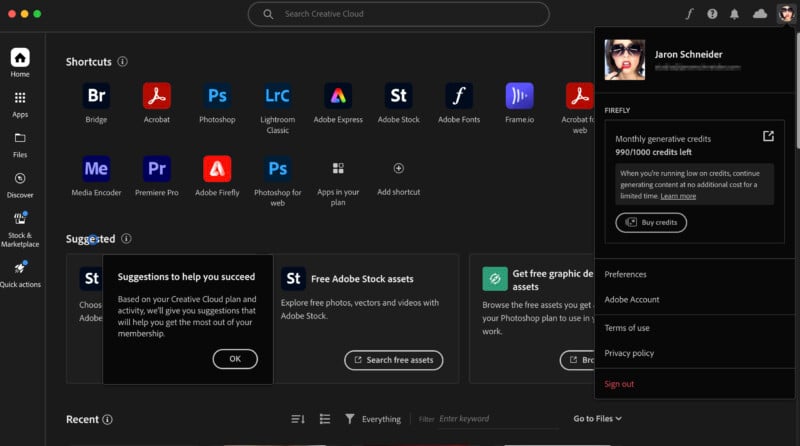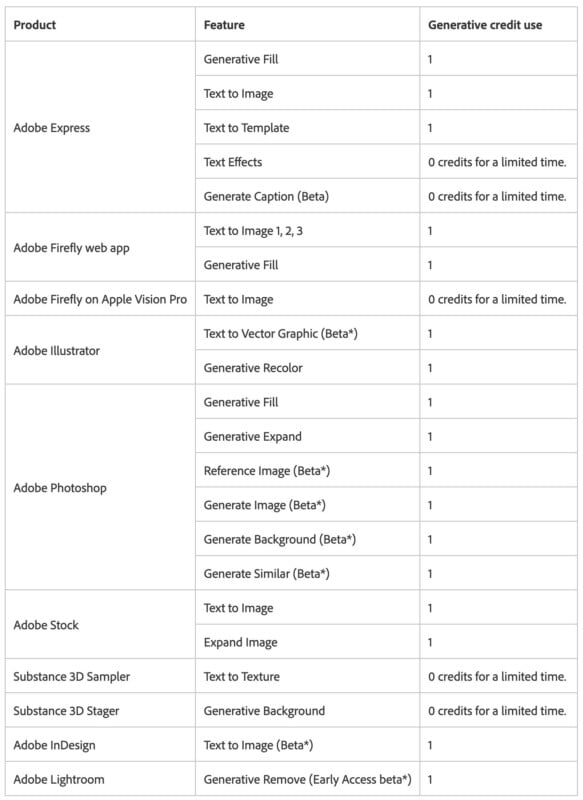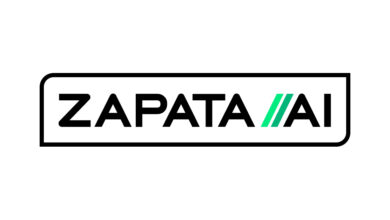Adobe’s AI Tools in Photoshop and Lightroom To Be Limited by ‘Generative Credits’

When Adobe launched its Firefly generative AI, it noted that using it would have limits determined by what it calls Generative Credits. Those limitations will soon include all Firefly-powered tools in Photoshop and Lightroom, too.
Adobe started tracking Firefly-enabled use per user at the beginning of 2024, but photographers and graphic designers probably didn’t realize that their work in Adobe’s flagship Photoshop program incurred the use of generative credits since the company wasn’t particularly forthcoming about it; that is to say, Adobe didn’t push a notification to users at all.
While the company was not proactive about alerting users to this change, Adobe does have a detailed FAQ page that includes almost all the information required to understand how Generative Credits work in its apps. As of January 17, Adobe started enforcing generative credit limits “on select plans” and tracking use on all of them.
Enforcement and Notifications
Adobe tells PetaPixel that for most of its plans, it has not started enforcement when users hit a monthly limit even if it is actively tracking use.
“Starting January 17, 2024, we will begin enforcing generative credit limits on select plans, including but not limited to Adobe Firefly,” Adobe says. “For a limited time, Creative Cloud, Adobe Express, and Adobe Stock paid subscribers won’t be subject to generative credit limits, even though they’ll see the counter on the account page.”
These usage number exist now because it says it wants to be transparent about usage so that when it does start enforcing these limits, users can see how much they’ve used historically. It’s not clear when Adobe will actually start to enforce limits and block features if Credits are expended. It also begs the question: Why is Adobe selling access to more credits if they’re not needed? More on that below.
Along that same line of thinking, Adobe says that it hasn’t provided any notice about these changes to most users since it’s not enforcing its limits for most plans yet. Adobe does not seem to have any plans to put warnings or notifications in its apps to alert users when they are running low on Credits either, even when the company does eventually enforce these limits.
Of note, the top of this page — and the one that is linked to from the Creative Cloud app under “learn more” — does not mention that Adobe isn’t tracking usage. It infers the opposite:

Adobe’s employees recently expressed concern that the company’s communications strategy leaves a lot to be desired and there are few better examples of that than this situation.
How Many Adobe Generative Credits Do I Have?
There is no indication inside any of Adobe’s apps that tells a user a tool requires a Generative Credit and there is also no note showing how many credits remain on an account. Adobe’s FAQ page says that the generative credits available to a user can be seen after logging into their account on the web, but PetaPixel found this isn’t the case, at least not for any of its team members.

Instead, users will need to either click on their profile picture on the Firefly website or do the same inside Adobe’s Creative Cloud desktop or web app. There, a user’s remaining number of generative credits is shown and it reloads in real-time.

Generative Credits are refreshed monthly, don’t roll over, and can’t be shared among users. The amount a user is provided depends on their account level. If a user is subscribed to the All Apps plan, they receive 1,000 credits per month. Those subscribed to Illustrator, InDesign, Photoshop, Premiere Pro, After Effects, Audition, Animate, Adobe Dreamweaver, Adobe Stock, and Photography 1TB single app plans receive 500 per month.
Photographers subscribed to the Creative Cloud Photography 20GB plan get 250 credits, but only if they subscribed before November 1, 2023. If they subscribed after, they only receive 100. Similarly, photographers subscribed to Lightroom as a single app also only receive 100 credits regardless of when they signed up.
The lowest tier is for those who subscribe to InCopy, Substance 3D Collection, Substance 3D Texturing, or Acrobat Pro as single apps. They receive just 25 monthly credits.
Additional credits can be purchased through the Creative Cloud app, but only 100 more per month. That costs $4.99 a month if billed monthly or $49.99 if a full year is paid for up-front. Again, even these additionally purchased credits do not roll over if they are not used and there does not appear to be an option to purchase more than 100 additional credits per month — at least not one that appears before burning through all credits already purchased.
What Incurs the Use of an Adobe Generative Credit?
In Photoshop, Adobe charges users one credit for using Generative Fill and Generative Expand, which are in full production, but will also charge for access to Reference Image, Generate Image, Generate Background, and Generate Similar which are tools that are in beta.
Similarly, Adobe’s newly-announced Generative Remove tool in Lightroom — a tool that is classified as “Early Access beta” — also incurs a Generative Credit per use.
Below are all of the tools that use a Generative Credit across all of Adobe’s platforms (as of June 2024):

Adobe has some language included that appears to be a holdover from the initial launch of Firefly. For example, the company stipulates that the Credit consumption rates above are for what it calls “standard images” that have a resolution of up to 2,000 by 2,000 pixels — the original maximum resolution of Firefly generative AI.
To test these limits, PetaPixel asked Photoshop to generate an image at 15,000 by 15,000 pixels. It successfully did and only charged the one Generative Credit. That said, Adobe adds that usage rates may vary and plans are subject to change, so it’s possible higher resolution generations will cost more credits in the future, subject to Adobe’s discretion.
‘Charging’ for Beta Use and Other Concerns
Strangely, Adobe is charging Generative Credits to use beta features, especially since beta applications are pulling data from use to improve them and Adobe explicitly says that outputs from beta features, while they can be used commercially, aren’t eligible for indemnification. So despite the fact they aren’t finished, don’t offer indemnification, and are actively being used to assist Adobe in the tool’s development, users are charged full price for them as if they were in final production. Adobe will argue it’s not actively enforcing its rules so it’s not actually charging users, but that can change at any time. The best way to think of this is that Adobe isn’t charging users for beta features “yet.”
Further, PetaPixel argues that Adobe did not provide users with a satisfactory level of notification that these changes were taking place. Even if the company isn’t enforcing these limits yet, it didn’t tell users that it was tracking usage either. PetaPixel only became aware of Adobe’s changes this week despite the fact these new Credit rules were instituted in January. Also, despite taking part in a one-on-one detailed demonstration of the new Generative Remove tool in Lightroom last month, Adobe never once mentioned Generative Credits or that the new tool would require them.
Dipping back to the part where Adobe says it isn’t actually enforcing its Generative Credits: the lack of information and clarity is the issue here. Telling users it isn’t enforcing for “a limited time” is useless information without a timeline on what “a limited time” is. Why have a counter if it means nothing? Why sell credits without telling a user that they may only need them for some things even if they still see them depleting?
It is an unsettling obfuscation of the facts made worse because Adobe already shows a general disregard for its customers’ concerns both from the mouth of its leadership and its attitude towards the rights of its users, even if it will at times reverse course in response to backlash.
If you work at Adobe and would like to share a tip, email Jaron Schneider directly at [email protected] using a non-work device. Your identity and statements will be kept confidential.



